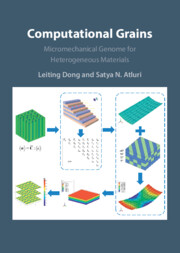Book contents
- Computational Grains
- Computational Grains
- Copyright page
- Contents
- Preface
- 1 Introduction
- 2 Computational Homogenization in the Micromechanics of Heterogeneous Materials
- 3 Direct Numerical Simulation of Materials Using Computational Grains
- 4 Trefftz Trial Functions for Computational Grains for Planar and 3D Problems
- 5 Computational Grains for Particulate Composites and Porous Materials
- 6 Computational Grains for Cylindrical Fiber Composites
- 7 Computational Grains for Nanocomposites
- 8 Computational Grains for Composites with Coated Inclusions
- 9 Computational Grains for Viscoelastic Composites
- 10 Computational Grains for Piezoelectric Composites/Porous Materials
- 11 Computational Grains with Embedded Microcracks in the Matrix and Inclusions
- 12 Multi-Scale Modeling of Composite Structures Using Computational Grains
- Index
- References
11 - Computational Grains with Embedded Microcracks in the Matrix and Inclusions
Published online by Cambridge University Press: 05 October 2023
- Computational Grains
- Computational Grains
- Copyright page
- Contents
- Preface
- 1 Introduction
- 2 Computational Homogenization in the Micromechanics of Heterogeneous Materials
- 3 Direct Numerical Simulation of Materials Using Computational Grains
- 4 Trefftz Trial Functions for Computational Grains for Planar and 3D Problems
- 5 Computational Grains for Particulate Composites and Porous Materials
- 6 Computational Grains for Cylindrical Fiber Composites
- 7 Computational Grains for Nanocomposites
- 8 Computational Grains for Composites with Coated Inclusions
- 9 Computational Grains for Viscoelastic Composites
- 10 Computational Grains for Piezoelectric Composites/Porous Materials
- 11 Computational Grains with Embedded Microcracks in the Matrix and Inclusions
- 12 Multi-Scale Modeling of Composite Structures Using Computational Grains
- Index
- References
Summary
By rearranging the weakly singular boundary, integral equations developed by Han and Atluri, an SGBEM-CG, which is abbreviated as CG, is developed in this chapter. The CG, representing a single grain of a material, can include arbitrarily shaped voids, inclusions (of a different material), and microcracks. The CG has a stiffness matrix and a load vector, which have similar physical meanings to the traditional displacement FEM. The stiffness matrix is symmetric, positive-definite, and has the same number of rigid-body modes. Different CGs, each with different isotropic material properties, can be directly coupled by the assembly procedure, and are used to directly and efficiently model the microstructure of heterogeneous composite materials. Some examples are also presented, with microcracks interacting with inclusions and holes. This provides some insight of a possible future study of the micro-cracking and damage of heterogeneous material. By introducing stochastic variations of the shapes of CG, and stochastic variations of the properties of the constituent materials, the realistic statistical bounds on the overall properties of composite materials will be determined in future studies.
Keywords
Information
- Type
- Chapter
- Information
- Computational GrainsMicromechanical Genome for Heterogeneous Materials, pp. 206 - 236Publisher: Cambridge University PressPrint publication year: 2023
